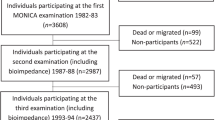Abstract
OBJECTIVES: To assess the relationship between body mass index (BMI; kg/m2) and mortality in a large nationally representative sample of US adults over age 70 years. DESIGN: Prospective longitudinal cohort study, the Longitudinal Study of Aging (LSOA). Subjects were all those 7260 black and white people (2769 men, 4491 women) initially interviewed in 1984 for whom height and weight were available. These subjects were followed through to 1990. MEASUREMENTS: Measurements included self-reported height and weight, date of death if subjects died, sex, age, race, measures of socio-economic status, number of living first degree relatives, and responses to questions asking whether the subject had retired due to poor health, had difficulty eating, worried about their health, and felt their health was worse than during the prior year. Smoking status was not assessed. RESULTS: When analyzed via Cox proportional hazard regression, the relationship between BMI and mortality, represented by means of hazard ratio, was clearly U-shaped for both men and women. The base of the curves was fairly wide suggesting that a broad range of BMIs are well tolerated by older adults. The minimum mortality (estimated from the fitted proportional hazard models) occurred at a BMI of approximately 31.7 for women and 28.8 for men. The results were essentially unchanged, if analyses were weighted, if various disease states were controlled for, and if apparently unhealthy subjects were excluded. CONCLUSIONS: The finding of the relatively high BMI (27–30 for men, 30–35 for women) associated with minimum hazard in persons older than seventy years supports some previously documented findings and opposes others and, if confirmed in future research, has implications for public health and clinical recommendations.
This is a preview of subscription content, access via your institution
Access options
Subscribe to this journal
Receive 12 print issues and online access
$259.00 per year
only $21.58 per issue
Buy this article
- Purchase on Springer Link
- Instant access to full article PDF
Prices may be subject to local taxes which are calculated during checkout
Similar content being viewed by others
Author information
Authors and Affiliations
Rights and permissions
About this article
Cite this article
Allison, D., Gallagher, D., Heo, M. et al. Body mass index and all-cause mortality among people age 70 and over: the Longitudinal Study of Aging. Int J Obes 21, 424–431 (1997). https://doi.org/10.1038/sj.ijo.0800423
Received:
Revised:
Accepted:
Issue Date:
DOI: https://doi.org/10.1038/sj.ijo.0800423
Keywords
This article is cited by
-
Body mass index and the risk of all-cause mortality among patients with nonvalvular atrial fibrillation: a multicenter prospective observational study in China
European Journal of Clinical Nutrition (2017)
-
Biological age and tempos of aging in women over 60 in connection with their morphofunctional characteristics
Journal of Physiological Anthropology (2014)
-
Scoping review report: obesity in older adults
International Journal of Obesity (2012)
-
A systematic review of the literature concerning the relationship between obesity and mortality in the elderly
The Journal of nutrition, health and aging (2012)
-
The ‘obesity paradox’: a parsimonious explanation for relations among obesity, mortality rate and aging?
International Journal of Obesity (2010)


